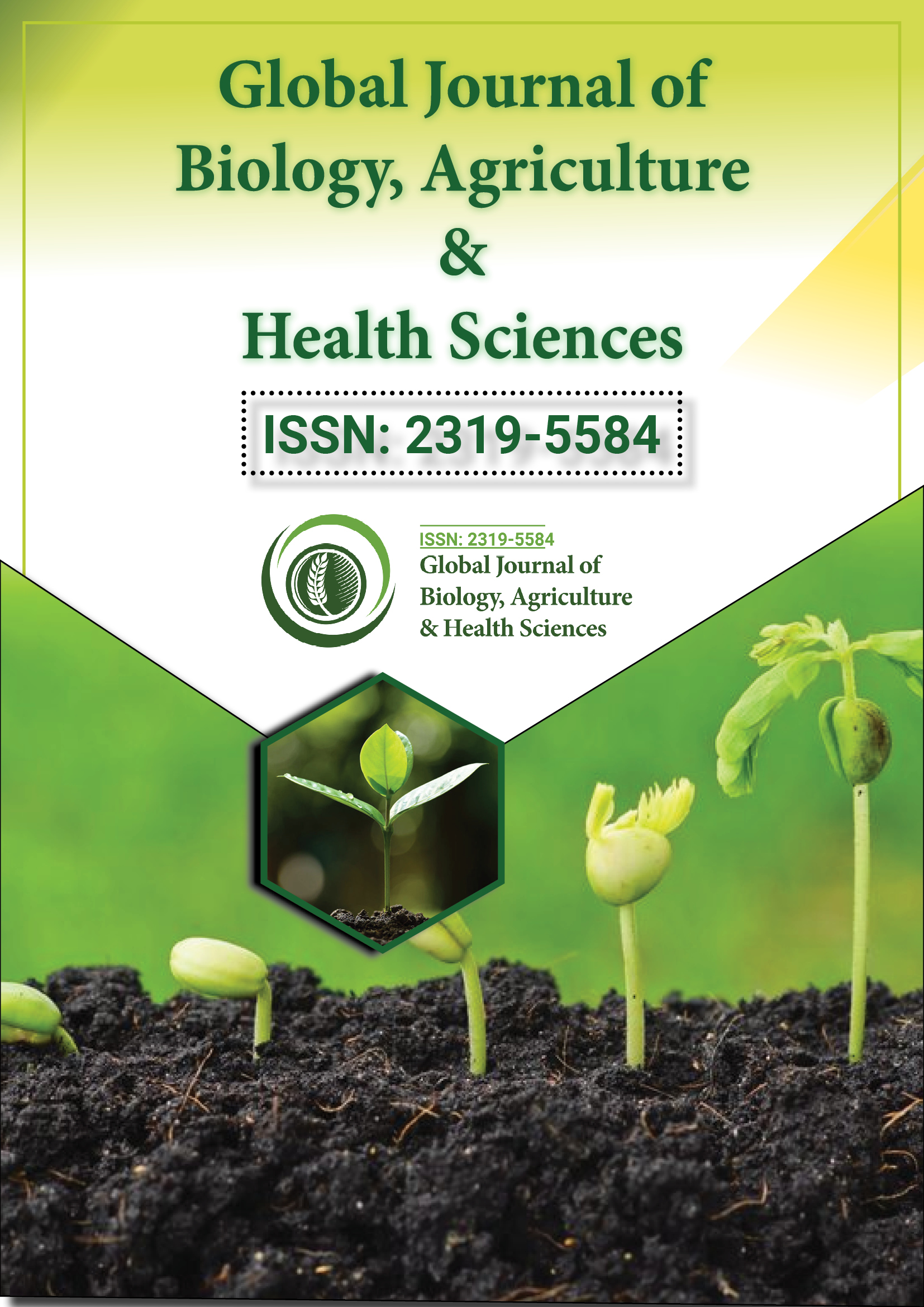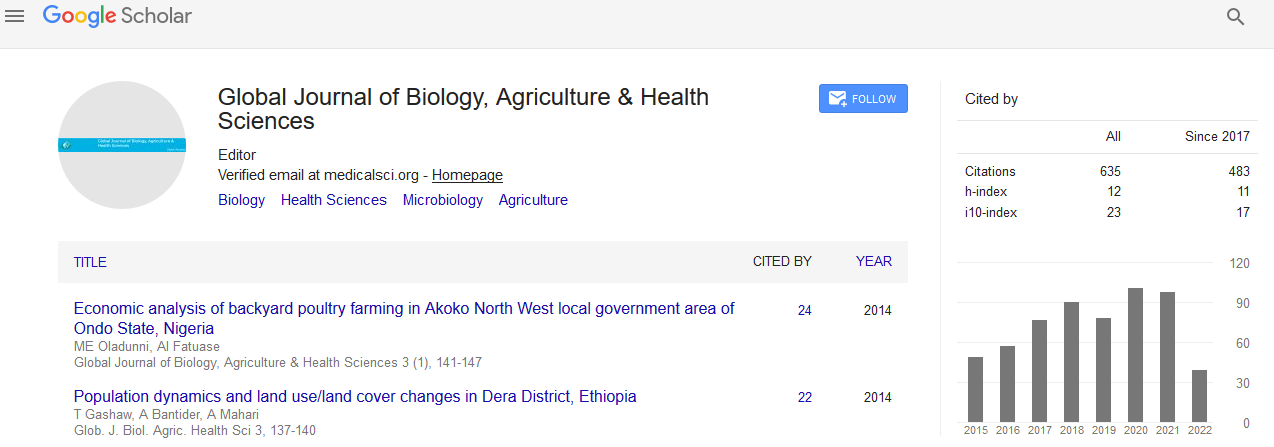Indexed In
- Euro Pub
- Google Scholar
Useful Links
Share This Page
Journal Flyer

Open Access Journals
- Agri and Aquaculture
- Biochemistry
- Bioinformatics & Systems Biology
- Business & Management
- Chemistry
- Clinical Sciences
- Engineering
- Food & Nutrition
- General Science
- Genetics & Molecular Biology
- Immunology & Microbiology
- Medical Sciences
- Neuroscience & Psychology
- Nursing & Health Care
- Pharmaceutical Sciences
Opinion Article - (2025) Volume 14, Issue 2
Enhancing Nutritional Quality of Staple Crops via Biofortification
Priya Menon*Received: 26-May-2025, Manuscript No. GJHABS-25-29937; Editor assigned: 28-May-2025, Pre QC No. GJHABS-25-29937 (PQ); Reviewed: 11-Jun-2025, QC No. GJHABS-25-29937; Revised: 18-Jun-2025, Manuscript No. GJHABS-25-29937 (R); Published: 25-Jun-2025, DOI: 10.35248/2319-5584.25.14.255
Description
Staple crops such as rice, wheat, maize, and millet form the bulk of caloric intake for much of the world’s population. While they supply energy, they often lack sufficient levels of micronutrients like iron, zinc, vitamin A, and folate. Biofortification is the process of increasing nutritional content of crops by genetic, agronomic, or breeding methods, aiming for more nutritious food at point of consumption. Improved nutritional value can reduce prevalence of micronutrient deficiencies which lead to health problems such as anaemia, impaired immunity, and developmental delays.
Genetic approaches involve selecting or introducing gene variants that enable crops to accumulate more target nutrients. Traditional breeding has succeeded in creating rice varieties with higher zinc content, for example. Molecular breeding techniques, using marker assisted selection, speed up the identification of lines that possess favorable alleles. In some cases transgenic methods, when allowed and regulated, can introduce new biosynthetic pathways, such as those producing provitamin A. Agronomic methods include fertilization strategies, soil amendments, or foliar sprays containing micronutrient compounds. For zinc, applying zinc sulphate to soil or leaves has shown measurable increases in grain zinc concentration in wheat. Similarly, iron fertilization can enhance iron content under certain soil types, though uptake and translocation to edible parts depend on plant variety and soil chemistry.
Crop varieties differ in their capacity to take up nutrients, translocate them, and deposit them into edible tissues. Genetic variation exists among landraces and wild relatives of crops, which often hold alleles lost in modern cultivars. Exploring this variation via germplasm screening, especially for root traits like root depth, surface area, and mycorrhizal associations, helps identify lines more efficient in nutrient uptake. Additionally, traits like phytate content (an antinutrient that binds to minerals making them less available to human digestion) matter: even if total mineral content is high, absorption may be low. Low-phytate variants aid in improving mineral bioavailability.
Environmental factors play a role. Soil pH, organic matter, moisture, presence of competing ions, and microbial communities affect how nutrients are taken up and mobilized. Iron in alkaline soils is often poorly available to plants. Microbial interactions, especially those involving root symbionts, sometimes assist in mobilizing trace elements. For example, certain soil bacteria produce siderophores that solubilize iron, making it more accessible to plants. Practices such as crop rotation or integration of legumes can improve soil health, influence pH, and thereby indirectly enhance micronutrient uptake.
Several case studies illustrate successful implementation. A project in Nepal with zinc enriched wheat resulted in reduced incidence of zinc deficiency symptoms among children. In Southeast Asia, rice lines with increased proâ?vitamin A were developed and released; in communities consuming such biofortified rice, measures of vitamin A status improved. Maize breeding programs in Subâ?Saharan Africa for both provitamin A and quality protein maize show gains in both nutrient content and yield stability under variable climate. However, some trade off appear high nutrient accumulation sometimes reduces yield or increases susceptibility to stress. Hence breeding efforts must balance nutritional quality with agronomic performance, adaptability, yield, and resistance to pests and disease.
Socioeconomic considerations are essential. Farmers must accept new varieties, which may differ in appearance, cooking behaviour, or yield. Consumers may resist changes in taste, colour, or texture. Seed distribution systems must reach remote areas. Often, smallholder farmers lack access to seed, fertilizer, or knowledge about cultivation of new varieties. Extension services are needed to assist both farmers and consumers to understand benefits and manage transition. Regulatory approval and quality control are required when new genetic lines are introduced to prevent unintended consequences or reduce variability among batches.
Conclusion
Improving nutritional content of staple crops through biofortification is an effective means to improve public health. Genetic and agronomic methods together can raise levels of micronutrients. Success depends on understanding plant variety, soil and environment, ensuring acceptability among farmers and consumers, and sustained support from policy and extension systems. When implemented well, such strategies reduce deficiencies and contribute to population health in regions where diet diversity is limited. Policy supporting biofortification helps scale adoption. Incentives for crop breeders, funding for breeding programs, subsidies for micronutrient fertilizers, and support in distribution networks all contribute.
Citation: Menon P (2025). Enhancing Nutritional Quality of Staple Crops via Biofortification. Glob J Agric Health Sci. 14:255.
Copyright: © 2025 Menon P. This is an open-access article distributed under the terms of the Creative Commons Attribution License, which permits unrestricted use, distribution and reproduction in any medium, provided the original author and source are credited.

